#(( Or that reefs are animals and not rocks or algae! ))
Explore tagged Tumblr posts
Note
Zuma, dude! Your aqua facts are so cool!🤙🏻 I love ocean life and learning about it!😁🦈🐳🐬🦑🦐🐙🪸🪼

Thanks!! It's a big project, there's a lot more to come every Friday! I hope this will help our followers and other people to learn a little bit about all kinds of aquatic animals and come to take better care of this diverse environment.
#oceanicwolf47#(( Dude there are people even now who think crabs have teeth and will BITE instead of y'know pinching with their claws ))#(( A lot of people from Poseidon's Cabin in the Percy Jackson fandom doesn't even know what a Hermit Crab is! ))#(( Or that reefs are animals and not rocks or algae! ))#(( Besides let's have Zuma know about his special interest and the things he works with shall we?? lol ))#Paw Patrol#Paw Patrol Zuma#Aqua Facts With Zuma#Justice For Zuma
12 notes
·
View notes
Note
Wait, which animals raise livestock?
Several species of ants will 'herd' aphids around (a type of plant lice)- even picking them up and putting them back with the group if they wander off. The ants will attack anything that approaches their aphid herds, defending them. The aphids produce a sugary excretion called honeydew, which the ants harvest and eat.
Some ants will even 'milk' the aphids, stroking the aphids with their antennae, to stimulate them to release honeydew. Some aphids have become 'domesticated' by the ants, and depend entirely on their caretaker ants to milk them.
When the host plant is depleted of resources and dies, the ants will pick up their herd of aphids and carry them to a new plant to feed on - a new 'pasture' if you will.
Some ants continue to care for aphids overwinter, when otherwise they'd die. The ants carry aphid eggs into their own nests, and will even go out of their way to destroy the eggs of aphid-predators, like ladybugs.
--
Microhylids – or narrow-mouthed frogs - have an interesting symbiosis with Tarantulas.
While the spiders could very easily kill and eat the much-tinier frogs, and DO normally prey on small frogs, young spiders instead will use their mouthparts to pick up the microhylid frogs, bring them back to their burrow, and release them unharmed.
The frog benefits from hanging out in/around the burrow of the tarantula, because the tarantula can scare away or eat predators that normally prey on tiny frogs, like snakes, geckos, and mantids. The tarantula gets a babysitter.
Microhylid frogs specialize in eating ants, and ants are one of the major predators of spider eggs. By eating ants, the frogs protect the spider's eggs. The frogs can also lay their eggs in the burrow, and won't be eaten by the spider.
So it's less 'livestock' and more like a housepet - a dog or a cat. You stop coyotes/eagles from hurting your little dog/cat, and in return the dog/cat keeps rats away from your baby.
--
Damselfish grow algae on rocks and corals. They defend these gardens ferociously, and will attack anything that comes too close - even humans. They spend much of their time weeding the gardens, removing unwanted algaes that might overtake their crop.
The species of algae that they cultivate is weak and and sensitive to growing conditions, and can easily be overgrazed by other herbivores. That particular algae tends to grow poorly in areas where damselfish aren't around to protect and farm it.
Damselfish will ALSO actively protect Mysidium integrum (little shrimp-like crustacians) in their reef farms, despite eating other similarly sized invertebrates. The mysids are filter feeders, who feed on zooplankton and free-floating algae, and their waste fertilizes the algae farms. Many types of zooplankton can feed on the algae crop, and the mysids prevent that.
While Mysids can be found around the world, the only place you'll find swarms of Musidium integrum is on the algae farms that Damselfish cultivate.
Damselfish treat the little mysids like some homesteaders treat ducks. Ducks eat snails and other insect pests on our crops, and their poop fertilizes the land. The ducks can be eaten, but aren't often, since they're more useful for their services than their meat.
--
There are SEVERAL species of insect and animal which actively farm. They perform fungiculture and horticulture: deliberately growing and harvesting fungus and plants at a large-scale to feed their population.
Leaf-cutter ants and Termites both chew up plant material and then seed it with a specific type of fungus. The fungus grows, and the termites/ants harvest the mushroom as a food source.
Ambrosia beetles burrow into decaying trees, hollow out little farming rooms, and introduce a specific fungii (the ambrosia fungi), which both adults and larval beetles feed on.
Marsh Periwinkles (a type of snail) cultivates fungus on cordgrass. They wound the plant with their scraping tongue, then defecate into the wound so their preferred fungus will infect it and grow there. They let the fungus grow in the wound a bit, and come back later to eat.
8K notes
·
View notes
Text
Round 1 - Phylum Cnidaria




(Sources - 1, 2, 3, 4)
Cnidaria is a phylum of aquatic animals which includes the Anthozoans (sea anemones, corals, sea pens), the Scyphozoans ( true jellies), the Cubozoans (box jellies), the Hydrozoans (a diverse group ranging from Hydras to the colonial Portuguese Man O’ War), the Staurozoans (eight-tentacled cnidarians that cling to seaweeds and rocks), and the parasitic Myxozoans and Polypodiozoans.
Cnidarians are identified by a decentralized nervous system distributed throughout a gelatinous body, and specialized explosive stinging cells, called cnidocytes, on ejectable flagella (“tentacles”) which are used to envenomate prey ranging from plankton to animals several times larger than themselves. Their bodies consist of a jelly-like substance called mesoglea sandwiched between two thin cell layers. Cnidarians are some of the only animals that can reproduce both sexually and asexually.
Many species of Cnidarian are actually groups of polyps, called zooids, clustered together to form one collonial organism. Corals, the Man O’ War, and Siphonophores are examples of this.

Propaganda below the cut:
Corals support 25% of all ocean life
Reefs are formed when coral polyps group together and produce a skeleton of calcium carbonate at their bases. They do this to form a platform that allows them to better stick together.
In a relationship that dates back to the Triassic, the symbiotic algae that live within corals gives them their colors, as well as creates nutrients for both organisms
Corals are facing a mass extinction due to climate change
While anemones are mainly sessile, usually staying in one place for weeks to months at a time, they can creep along on their bases at a speed too slow to be seen with the naked eye. However, some species can move or “swim” quickly in a pinch. Gonactinia can crawl like an inchworm, Paranthus rapiformis can curl into a ball and roll around, and Stomphia coccinea can swim by flexing its column. They just look really silly doing so.
Anemones are predators, stinging prey and pulling it into their mouth with their tentacles. They can eat animals as large as crabs, mollusks, and even small fish. However, some fish and invertebrates have a symbiotic relationship with anemones. Immune to the anemone’s venom, these animals utilize it as shelter while keeping it clean and providing it with nutrients from their feces. Some hermit crabs even carry anemones on their shells, providing the anemone with quick transport to new areas in return for protection.
Box Jellies have simple eyes, are capable of pursuing and reacting to prey behavior, and some species are some of the most deadly animals in the world.
The Lion’s Mane Jelly (Cyanea capillata) is one of the largest jellyfish, with the largest recorded specimen having a bell width of 210 cm (7 ft) and tentacles around 36.6 m (120 ft) long.
The Lion’s Mane Jelly is also the favorite food of Leatherback Sea Turtles.
A rise in jellyfish population can signify ecosystem collapse
The Giant Siphonophore (Praya dubia) is a collonial Hydrozoan that can get up to 50 m (160 ft) long, rivaling the Blue Whale in length.
Some Cnidarians can “hear” via vibrations, and some can even produce sounds to communicate
Many Cnidarians are bioluminescent
132 notes
·
View notes
Text
Fish of the Day
Today's fish of the day is the reef triggerfish!

The Reef Triggerfish, also known by Hawiian name humuhumunukunukuāpua��a, and scientific name Rhinecanthus rectangulus, is known for its prevalence across the indo-pacific, and for being Hawaii's state fish! Their range stretches from the Hawiian islands to the Eastern Philippines,Northern Australia, Indian ocean, small sections of the red sea, and the mediterranean. This fish lives its life out along reefs and other sea shelves, as their hunting style consists mostly of digging in the sand and rocks for prey, similar to pigs digging for truffles. Their diet consists of reef invertebrates, algae, small crabs, sea urchins, and other benthic animals. This diet can support them to sizes of 10-12 inches, which is the smaller range for triggerfishes.

These fish, like many other triggerfish, gain their name from their ability to fire and aim jets of water, which it will also use to hunt and find prey beneath the surface. They also will use this against other fish and larger beings in their territory, as reef triggerfishes are intensely territorial, and solitary other than in breeding season. This can manifest in cases where reef triggerfish chase and bite humans viewing reefs. When met with predators, the reef triggerfish, similar to other triggerfish, finds small holes within rocks or corals that it will lodge itself within. The first dorsal spine will act as a physical barrier that can lock in an upright position, making it harder for predators to pry it out of their safe havens. Due to the shape of their spines and fins, these fish can swim forward, backward, and hover in the water.
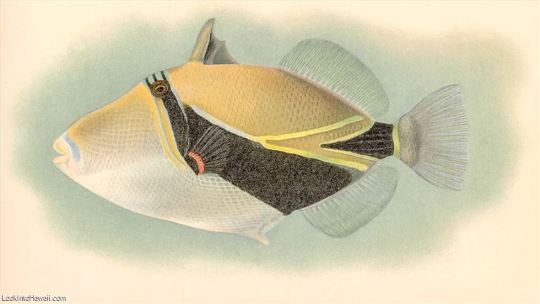
Like most fishes, reef triggerfish have a breeding season from April-August, and classically have females lay eggs and males fertilize in groups. This being the one of the only times they interact with other of their species intentionally. Then after this, a female will build a nest, and wait with eggs until a few weeks after they hatch, at which point the fish will set out independently. Reef triggerfish can also change coloration, turning a more vibrant shade for breeding seasons. They will also present vibrantly when healthy, sexually mature, and unthreatened. They can also change colors to better match an environment around them, and do so nightly when they settle into holes to rest.

Have a wonderful day, everyone!
#fish#fish of the day#fishblr#fishposting#aquatic biology#marine biology#animal facts#animal#animals#fishes#informative#education#aquatic#aquatic life#nature#river#ocean#reef triggerfish#triggerfish
58 notes
·
View notes
Text

Seas of Pern
While the land ecosystems still suffer from the mass extinction caused by the first Threadfall, the marine life of Pern thrives untouched. A variety of species vastly exceeding that on Earth fills the planet's oceans, especially in the shallow coastal waters. Strange native creatures like something out of Terran prehistory coexist with species introduced by colonists. A little group of sea sheep heads toward a clump of bubble kelp which normally forms enormous floating forests, but this cluster was torn off by a recent storm. Albacore tuna, now unburdened by industrial fishing, thrives in thousand-headed schools all over the seas, their distinct silver scales setting them apart from the colorful scaleless pernese species. Nearby, a giant feathertail mother leads her brood toward new feeding grounds where a trio of shipfish dance in the currents and a pernese sunfish queen shows off her breeding colors, accompanied by a bronze partner. The rocks provide a home of countless kinds of coral-like creatures and colorful algae as well as various eels and other reef fish. Armorfish of all shapes and sizes snoop around the sandy bottom, their beetle-like carapaces often glistening with opal-like sheen. A green bowlcrab seems to have taken interest in the camera.
This is my first drawing for a little project I'm planning, in which I want to explore the missed potential of Pern's wildlife. There is very few species mentioned by canon so the vast majority of animals will be my own creation.
#pern#dragonriders of pern#worldbuilding#gonna be basing most of pernese creatures (especially marine and amphibious ones) on prehistoric creatures#working with the logic that Pern didn't have the same extinctions as Earth did so life took all sorts of different wacky turns there
72 notes
·
View notes
Text
Merman x Siren au
Hualian - (part X)

First part: PART I
Previous part: PART IX
***
Xie Lian follows the siren without any more comments. He's too embarrassed to start a conversation after all. San Lang (or rather Hua Cheng; Xie Lian still isn't sure if that's really the same creature the Emperor told him about) swims a little at the front, guiding the merman wordlessly. He tried to swim arm to arm with Xie Lian, but after the comments about the rushed heartbeat, the siren noticed that the merman didn't want to stay too close to him after all.
He doesn't seem to mind that though.
Xie Lian watches San Lang carefully, slowly noticing all the differences and similarities between the siren and himself. First, the most obvious thing is, of course, the terrifyingly long tail with sharp fins. Xie Lian himself has quite a long tail for a merman, but next to the siren he looks just... tiny. Not to mention only his tail fin is maybe half as tough as San Lang's. The rest of Xie Lian's fins are almost transparent - delicate and prone to injuries, unlike the siren's fins with strong, spike-like bases and thicker membranes. The creature's scales look stronger too, but Xie Lian doesn't dare to try and touch them to prove his theory.
Inspecting further, Xie Lian pays more attention to the siren's strong hands. His forearms are enveloped in something that the merman took for armour at first, but those turned out to be some kind of fins too, making the siren's hands even more dangerous - as if the deadly sharp claws weren't enough.
However, the upper part of the siren's body looks more pleasant and mermen-like, or rather humanoid. San Lang's black, silky hair follows his movements majestically, shining in the light of the day. Xie Lian can't see more than the toned back and wide shoulders from his perspective, but he already had a chance to see the front and he more or less has an idea of how the siren fully looks like.
What's most intriguing about San Lang are the strange marks all over his body. They remind Xie Lian of poping veins, but that's clearly not it - they're pitch black, fading into the siren's skin colour at places. Only the marks on San Lang's face and neck are more vivid, turning red to match his scales, but they aren't changing at all as they swim and swim, so Xie Lian comes to a consultation they might be scars.
However, he doesn't feel like asking about it is a good opening line after a longer period of silence. Especially since the siren probably is well aware that Xie Lian is staring. He can hear his heartbeat after all, so just how sharp are his senses?
As they go deeper into San Lang's territory, Xie Lian also notices that it's quite... empty. It's surely clean and net, but what they pass are mostly rock formations, small algae forests and kilometres of plain ocean bottom, sprinkled with light sand.
Just as Xie Lian is about to ask San Lang where exactly they're going, they turn a corner to leave the rock formation they are passing through and then they take a small dive.
Xie Lian immediately cancels his own thought about the emptiness of the siren's territory.
What they are now swimming towards is a huge coral reef, hidden behind the rock formation, fitting right into a depression in the ocean bottom. The amount of beautiful corals and plants, not to mention hundreds of animals Xie Lian can already see from where he is, is something the merman haven't even thought could exist so close to his home.
And it's all under the guard of the siren everyone speaks so ill of. How could such a cruel creature take care of a place like this?
"What's with that face?"
Only now Xie Lian realizes he slowed down a little bit too much, admiring the beautiful scenery. He looks back at San Lang, who has a teasing smile spread on his lips.
"No, no! It's nothing! I'm just—," Xie Lian stumbles over his words, feeling the embarrassment already washing over him yet again today.
"Hmm?" The siren encourages him to answer, cocking his eyebrow.
"I just... didn't expect you to have a home like this," Xie Lian finally clicks, looking down at his own hands.
"I wouldn't call it a home. Home is where a family is. Or a pod. I'm only by myself here," San Lang speaks up."But I hope you didn't expect me to live in a cold, empty cave, sleeping on the crania of my enemies?"
Well... that's kind of what Xie Lian expected, to be honest.
"I just didn't expect a whole coral reef! That's all! Because... I can't imagine how hard it is to look after everything here, there's no litter or any trace of human activity at all! It's impressive!"
The siren chuckles.
"Thank you," he says, smiling softly at the merman. Xie Lian doesn't know why, but he feels as if the water temperature suddenly rose up. "It's not that difficult after all. The coral reef is perfectly fine on its own without my intervention. As for humans... The smart ones know better than to enter the waters where everyone drowns. The idiots, on the other hand, prove that natural selection is a thing."
Even if the words aren't directed at him, Xie Lian feels a chill running down his spine. He nods unconsciously.
"Uh oh... Understandable," he mumbles, making the siren chuckle again.
"Come," San Lang says without any further explanation, turning around to dive into the coral reef.
Xie Lian follows obediently and soon after he finds himself in a small cave system hidden perfectly behind the corals. The entrance is big enough to fit only one of them at the time and it's carefully covered with plants to avoid any potential intruder.
Inside, there are a few small caves that serve as different rooms for the siren, or so Xie Lian thinks. The first one is the biggest and has some light coming in from the ceiling through the tiny holes, resembling Jun Wu's chambers a lot. However, San Lang doesn't stop there, casually passing through the cave to another one.
As Xie Lian swims into the smaller, dark cave right behind the siren, he immediately gets the idea of it being a resting place - and he's not wrong.
"You must be tired," San Lang speaks up from the shadow. "Come here."
"Sorry, I... Can't see much. I, I don't know where to..."
As Xie Lian stumbles on his clicks, he suddenly feels an arm wrapping around his waist. San Lang's presence appears as surprisingly and fast as always, making the merman shiver from the coldness of the siren's hands. Nevertheless, he lets himself be guided through the dark corridor, right into another cave.
Xie Lian finds himself unable to talk once again. What he sees is beyond any expectations he could have for a resting place.
The cave is small, but there's more than enough space to fit both of them. There's a huge ledge in the middle of it, covered in tiny corals that illuminate fade, colourful light - some small colonies of them are also situated on the walls and ceiling. Thanks to that, Xie Lian doesn't have to do his best to get used to the darkness anymore and is able to admire the beautiful cave for a while. He doesn't even realize when he's guided right onto the corals by the siren.
His tail touches the corals that not only fade a little as he lies down, but also turn out to be extremely soft. He's scared that he's going to destroy them, but as soon as he wants to swim up, San Lang firmly lies him down with a smile.
"Don't worry," he clicks, seeing right through the merman. One of his hands is still on the merman's waist as the other one tucks Xie Lian's stray strand of hair behind his ear - very slow and careful, as if he was afraid that any of his movements could cut the merman's skin due to how sharp his claws and spikes were. "The corals have great endurance. They won't break even if you want them to."
"Oh, okay," Xie Lian replies, slowly relaxing on the soft bedding - because that's what he thinks the ledge serves as.
And then it hits him.
He's in the siren's personal caves.
What's more - he's in San Lang's bed.
For merfolk it's a very important moment in life to show someone their resting place. They usually sleep alone until they mate and only then they share a cave with their significant other. Usually only close friends and family can visit one's caves, but to lay someone in their bed? That's one of the most intimate actions known to Xie Lian.
"You should rest. It was a long day for you, wasn't it? I will show you around tomorrow." San Lang says with a smile, but doesn't seem bothered by having Xie Lian here at all. Maybe it's just a guest room then? Xie Lian has no idea, but he's too embarrassed to ask questions.
"Uhm," he nods and looks down to not meet the siren's gaze - it would make him blush even more.
And then, suddenly, the siren withdraws and no longer holds Xie Lian. As much as the merman felt the coldness of his body when they were close to each other, now he feels even colder when San Lang doesn't hold him anymore.
"And you?" Xie Lian clicks before he can stop himself.
"Me?" San Lang asks after, cocking an eyebrow.
"Aren't you... going to rest too?"
The siren snorts, taking a small swim around the cave, as if he wanted Xie Lian to look around and notice more details about the place - there's a smaller ledge full of snacks and algae, and there's also a place with a tiny collection of tools that look like the human ones, but they were definitely crafted underwater. Xie Lian's eyes lit up when he notices those, eager to take a closer look.
"I need to go for a patrol," San Lang explains, making his way to the exit. "Feel free to rest or do whatever you want. I will be back soon."
With those words, the siren disappears into the darkness of the corridor, leaving the merman all by himself.
Xie Lian suddenly feels stripped of all his strength. He lies down flat on the soft corals and for a while thinks about whether he really wants to go over the tools or just rest, but before he can make a decision, he finds himself lured into a deep slumber by the luminescent corals.
He's never slept so soundly in his whole life.
***
Hello hello!! They're finally at Hua Cheng's place hehe~ Who would think he's such a softie (having a coral bed is a princess treatment!)??? Anyways! Lemme know how you liked the part!! They're going to be domestic for a while now before I decide how to make them miserable—
See you next week!!
Next part: PART XI
#tgcf#hualian#hua cheng#hualian au#mxtx tgcf#tgcf hua cheng#tgcf hualian#xie lian#mxtx#tgcf fanfic#merman au#merman#siren#tgcf xie lian#tian guan ci fu#heaven official's blessing#feng xin#mu qing#ruoye
30 notes
·
View notes
Text
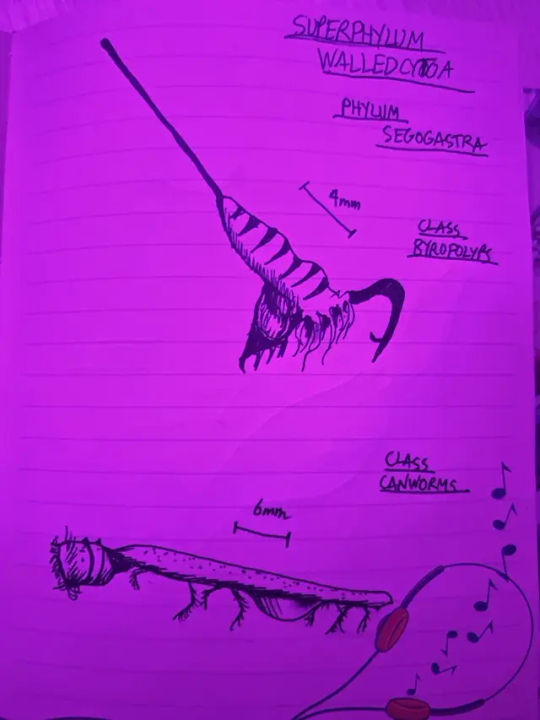
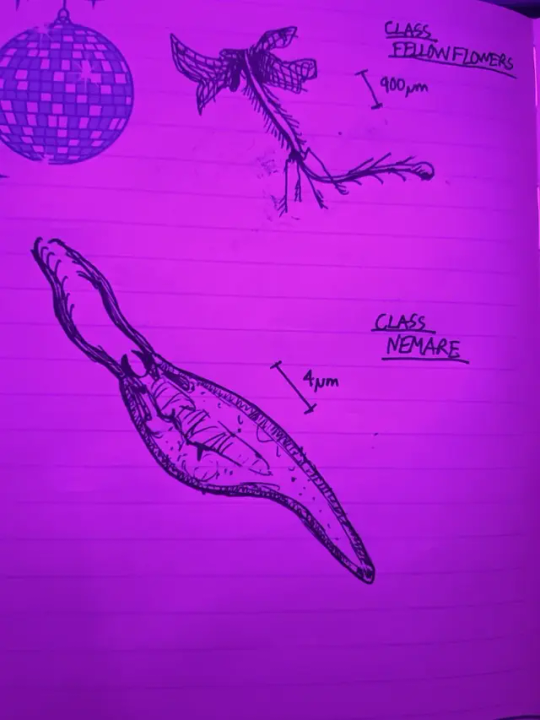
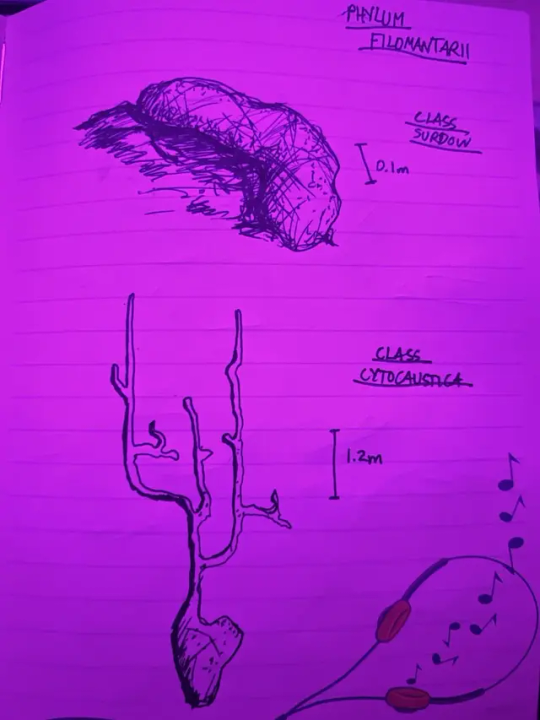
Now we begin to approach the last few groups of our classes of animals on Jom'Gol !! We gettin into the weird ones now !!!
Superphylum Walledcytoa
A taxa of animals possessing cell walls and a nacreous filament.
(AN2 C3) Clade: Introplastidae
A clade of walledcyota that vary in symmetry and possess an external tissue of keratin.
(AN2 C3-a) Clade: Segogastra
A clade of introplastids that possess longitudinal symmetry and an orifice-based method of nutrient absorption.
PHYLUM SEGOGASTRA
Phylum of entirely parasitic or mutualistic introplastids and the only extant phylum of Clade Segogastra.
(AN2 C3-ai) Clade: Apolyptuo Pseudoserpendae
A clade of animals that have no navigational limbs after development and attach to a host via a sickle-shaped tailhook.
(AN2 C3-ai-§1) Clade: Byropolypa
A clade of apolyptuo pseudoserpendae that contain one long proboscis to absorb nutrients and detritus matter.
Class Byropolyps
Only extant class of byropolypa; attaches to floral or faunal hosts via the tailhook and extends the proboscis end to filter-feed on passing matter. Nacreous filament deposited onto the host organism during death, containing small clone-lined spicules.
(AN2 C3-aii) Clade: Brachoserpendae
A clade of animals that contain branching filaments for latching, navigation, and feeding after development.
Class Canworms
Class of segogastrans that typically attach to faunal and mobile hosts and use a crown of teeth in a can-shaped head to feed on detritus, algae, invasive organisms, and the host’s indigestible consumed matter. Class is also capable of minimal ciliary locomotion to move to different areas along its host.
Class Fellowflowers
Class of segogastrans that typically attach to floral, fungal, or sessile faunal organisms and catch passing plankton with specialized net-like fringes. Organisms in this class often accompany other organisms that cannot obtain enough nutrients from their own niche, exchanging nutrients through the nacreous filament in mutualistic symbiosis.
(AN2 C3-aiii) Clade: Macronemare
A clade of organisms that contain only two tentacled ends for navigation and sensing.
(AN2 C3-aiii-§1) Clade: Nemare
A clade of macronemare that consumes fungi, flora detritus, and bacterial mats.
Class Nemare
Class of animals that are extremely microscopic and typically consume waste matter from a host (typically inside a host that is already a parasite of a greater host) or use predatory hunting to kill and consume bacterial and fungal mats within hosts.
(AN2 C3-b) Clade: Asymmetrical Cytoplastidae
A clade of introplastids that possess no symmetry and a semi-porous method of nutrient absorption.
PHYLUM FILOMANTARII
Phylum of quasi-multicellular terrestrial cytoplastids that have no internal organization and a non-newtonian external structure. All filomantarii solidify their outer membrane when exposed to stress, force, or low humidity.
Class Surdow
Class of filomantarii that navigate terrestrial rock surfaces to scavenge for bacterial, algal, chemotrophic, or sessile animals; class species range from microscopic to fairly large and can lie dormant for long periods of time.
Class Cytocaustica
Class of filomantarri that navigate active organisms in forests, intertidal zones, reefs, and organism-rich caves; class members usually contain a neutralizing and sterilizing agent in loosely assembled cells that dissolve the cell membranes of weak or deceased microorganisms.
#art#artists on tumblr#worldbuilding#jomgol#spec bio#spec evo#speculative biology#speculative evolution#traditional art#traditional drawing#traditional sketch#alien species#alien#creature design#creature#xenobiology#speculative worldbuilding#speculative zoology
20 notes
·
View notes
Text
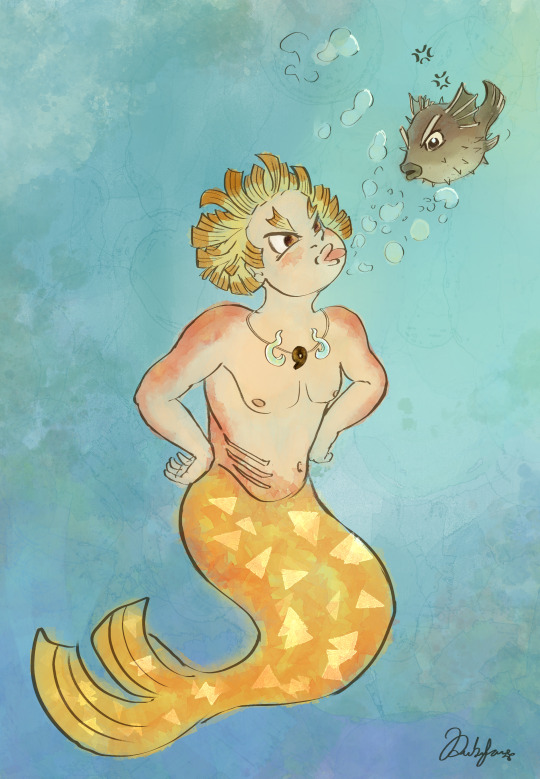
*Aggrieved pufferfish noises*
[Translators note: "You’re always whining about not wanting to go to work, you’re always hitting on girls, and you snore SO loud!"]
(no, I don't know what a pufferfish sounds like either)
____
Merman Zenitsu and pufferfish Chuntaro!
I was backing up some files earlier, and stumbled across this dumb AU doodle from a few years ago. Seemed appropriate to colour it with watercolours!
Cute little Chuntaro is a prickly pufferfish in this AU... but that raises the question: what marine species would the rest of the corps use to communicate underwater?
Swordfish are extremely fast swimmers, have convenient weapons/ letter clips stuck to their faces, excellent eyesight, are highly migratory loners with a massive range, and... ugh, fine. They're the obvious choice, aren't they?
Most members of the seaman slayer corps use swordfish.
Further fishy ideas beneath the cut:
Tanjirou:
My first instinct is to say sunfish, but the mental image of one of those massive creatures drifting menacingly behind him at all times is just too ridiculous.
And yet... somehow it makes perfect sense? A gentle giant that acts like a shield, patiently sheltering his sister from the sun whenever they travel near the surface.
Shinobu/ Kanao/Kanae: Butterfly fish, of course! All with polite and graceful personalities.
Shinobu fights using a variety of marine animal venoms including stonefish. Stonefish stings are treated with the applicaton of heat to denature proteins in the venom... so if Douma's an ice guy in this AU too, he's in for a rough time.
Inosuke: Briefly had a cute little pigfish, but he ate it within a day. Now he just has a regular corps- assigned swordfish. They're also tasty, apparently... if only he could catch it!
Tengen: Really wanted a Fireworks fish/ some other absurdly flamboyant tropical fish. Instead, he was assigned a bland- looking, tiny little fish that's well- suited to stealth missions.
It's been thoroughly ✨bedazzled✨by now and loves him. The most popular family member by far. Very plump and spoilt.
Gyomei: Green humphead parrotfish. These guys are massive, pretty docile, and spend most of their time crunching through rock- hard coral with big teeth to scrape off yummy algae, pooping out the rest as sand. They are cleaners that are instrumental in maintaining the health of coral reef ecosystems.
Gyomei's parrotfish is no exception; however, it used to be an insatiable glutton, to the point of destroying the coral reef it once resided in and being ostracised by its peers as a result. Wracked with guilt and with nowhere else to go, it received an invitation to serve in the corps. Its new master helped it learn self control.
Rengoku: There's no shortage of bold, flame- coloured fish species out there... but I reckon this guy just has the same generic swordfish species assigned to the rest of the corps. The only difference being that his used to be his father's loyal companion, and it's aged a bit, so it's not as speedy as it once was. It should've retired years ago, but refuses to abandon its self- imposed duty of keeping its master's son on the right path.
Was a rebellious playboy in its youth. Now it's a straight- laced military type, follows corps rules to the letter. Doesn't trust that slimy sea slug Nezuko one bit.
Sanemi: SAILFISH, hands down. Aggressive, vaguely wind- themed predator, and the fastest swimmer in the ocean. Both of them are pretty smug about that last point.
Genya: An archerfish would make sense thematically... but again, Genya just seems like another corps- assigned swordfish kinda guy to me? He definitely has a pet snapping turtle though. It's very small, and VERY grumpy.
Muchiro: A sweet natured blue- ringed octopus who wants nothing more than to be friends, but suffers from crippling social anxiety that makes it seem aloof and unapproachable.
Everyone is TERRIFIED of it except Tengen, who thinks it's flamboyant as heck, and Shinobu, who is simultaneously obsessed with it and wants to stab it dead.
Muchiro just ignores it, for the most part.
(Giyuu can relate).
Mitsuri: Blobfish lacking in self- confidence. Mitsuri thinks it's cute, and is absolutely correct in her opinion. Accepts cuddles from Mitsuri and Obanai only, and blushes at compliments. It's also insanely flexible, just like its master. Copes well under high pressure!
Giyuu: This man has a manta ray, no doubt about it. A creature of few words with a serene and peaceful disposition... yet inexplicably a huge social magnet that effortlessly draws everyone's attention (away from Giyuu). Especially popular with young merchildren, whom it often allows to ride on its back. Holds a deep respect for both its master and Urokodaki (who has a manta ray too, by the way).
Obanai: Had the toughest time deciding this one. A striped beakfish would match his colour scheme perfectly, but... I just don't think it suits him. A striped marlin, maybe? Anyone with more ideas, let me know!
Kaburamaru is a sea snake, obviously. A black- banded sea krait.
#This was hidden in one of my old uni lecture notes folders lol#was clearly paying attention that day#become a seaman slayer kids!#those evil humans are decimating the marine ecosystem with their overfishing!#ugh muzan as a random fisherman just isn't menacing enough though#he's a mutated freaky seamonster that attained the ability to walk on land maybe?#massive superiority complex over being “more evolved” than the merpeople#demon slayer#kimetsu no yaiba#zenitsu agatsuma#chuntaro#zenitsu#kny
34 notes
·
View notes
Photo



Stop a Moment for the Sand Striker
Also known as the bobbit worm, Eunice aphroditois is a marine bristle worm endemic to both the Atlantic and Pacific oceans, in waters up to 95 m (311 ft) deep. Because they spend most of their time under ground, the sand striker is rarely seen. However, they can be found in both coral reefs and deeper, rocky or sandy ocean floors-- anywhere they can hide and ambush prey.
This species of bristle worm is famous for its hunting methods. Individuals live in burrows deep under ground, with an entrance covered by sand or rocks, and only emerge at night. They keep these burrows stable by secreting a mucus-like substance which coats the sandy walls and keeps them in place. Because their eyes are rudimentary at best, sand strikers use their five antennae to sense passing prey-- usually fish, but also algae or organic debris. When their target is close enough, E. aphroditois ambushes it and drags it back down into the burrow with its large mandibles. This process is extraordinarily fast; bobbit worms have been clocked moving at 6 m (20 ft) per second. The mandibles are also retractible, which helps the bobbit worm swallow its prey.
Though only their heads are usually visible, the sand striker has an impressive body. They can grow to be 1- 3 m (3-10 ft) long, although they’re typically only 25 mm (1 in) wide. Like other bristle worms, their bodies are made up of segments, protected by a hard, irridescent exoskeleton. Most sand strikers are deep purple or black, although individuals in a variety of colors have been documented. In addition to their exoskeleton, bobbit worms also sport sharp, venomous tentacles down the length of their body to deter threats. Adults are typically avoided by other, larger predators, but juveniles can be targeted by fish.
E. aphroditois lacks external reproductive organs, and instead is a broadcast spawner. When they’re ready to mate, female sand strikers produce a pheromone that attracts males and signals them to release their sperm. The females them release their eggs into the water, where they become fertilized and develop into larvae. These larvae swim freely for several months to a year, during which many become food for other animals. The survivors begin to segment and burrow into the sand, where they become sexually mature. In the wild, bobbit worms can live anywhere from 3-5 years, though some biologists believe they may have a longer lifespan of 10-15 years.
Conservation status: E. aphroditois has not been evaluated by the IUCN. However, populations in coral reefs are threatened by habitat decline.
If you like what I do, consider leaving a tip or buying me a ko-fi!
Photos
Richard Zerpe
Department of Biomedicine, University of Basel
Chutinun Mora
#bobbit worm#sand striker#Eunicida#Eunicidae#marine polychaetes#polychaete worms#bristle worms#worms#segmented worms#annelids#invertebrates#marine fauna#benthic fauna#coral reefs#atlantic ocean#Pacific Ocean#indian ocean#Indo-Pacific
155 notes
·
View notes
Text
Some fun animal facts i want to share with everyone, since I've been info-dumping to strangers all day
Some single-cell bacteria can "see"! They don't have eyes in the sense that they can see shape and form, but they use their rounded membranes like a lens to focus incoming light and allow them to react to the light levels by moving towards or away from it based on their needs.
Horseshoe crabs, jellyfish, and sharks are all older than saturn's rings! Though we aren't 100% sure how old the rings are, it's thought that they're less than 400 million years old, with many scientists thinking they're only 100-200 million years old. Meanwhile, horseshoe crabs, jellyfish, and sharks are all well over that number, with horseshoe crabs as the "youngest" species at only about 445 million years old!
The sex of many reptiles is determined by the temperature of their egg, rather than genetics. Though the individual babies are genetically identical, certain genes are "turned on or off" at certain temperatures during the embryonic development, changing the hormones and anatomical structures that develop.
Moss (isn't an animal, but i'm getting there) is a primitive/simple plant that can come in a variety of structures. Some have leaves and stems, while others are even simpler than that. These tiny forests provide the perfect biome for a massive variety of microbes, lending them the moniker the coral reef of the forest. There are even old growth moss forests, with thousands or millions of tiny animals living inside a patch of green on a rock.
Speaking of coral, it's an animal! Coral is what we call a colonial species, with one structure made up of hundreds or thousands of identical organisms known as polyps. Most coral have a symbiotic relationship with an algae that grows inside their structure, receiving nutrients and food in exchange for providing a place to live.
While coral is stuck in place, Sea Anemones can swim! Though they prefer to spend their lives sitting in one spot, this can be trouble when a predator gets too close, or the environment becomes dangerous. When this happens, the anemone will detach from its spot and wiggle away. Watch it move at the youtube video linked here.
Finally, not a lot of people know the difference between a sea lion and a seal, but it's actually very easy! A sea lion can push itself upright using its front flippers and has ear flaps, while a seal is used by official bodies such as governments or notaries to enact a legal document, or legitimize a document's authenticity.
7 notes
·
View notes
Text
Fifth Creature Design: Iteration 1 - with Research
For this iteration, I decided it would be more interesting to design a creature that was based on a single coral polyp, to show how it could have evolved to begin coral growth on land, as this would also give it a meaning for existing there to begin with. For me to create a convincing design, however, I first did some research to find out what a coral polyp was.

What is a coral Polyp?
A polyp is an animal. Most polyps are tiny and live in clusters called ‘colonies.’ Polyps may have hard or soft skeletons. Of the 2,400 living species of corals worldwide, two-thirds of the known coral species have soft skeletons, while one-third of the species have hard skeletons. The type of polyp determines the size and shape of the colony. Some colonies look like “trees” while another colony may look like a brain.
Most soft coral polyps only have eight legs (except sea anemones) whereas other polyps have twelve, eighteen, or even twenty-four legs. Colonies of soft corals include soft tree corals, sea pens, sea whips, sea fans, and sea anemones.
Here is a diagram I found of a coral polyp:

I decided it would be best to keep the shape of my design similar to a real coral polyp so that it would be more convincing.
How do Coral Polyps eat?
At night coral polyps come out of their skeletons to feed. A polyp uses tentacles to sting and capture tiny floating animals called zooplankton. The polyp’s mouth swallows the zooplankton. The zooplankton is digested in the polyp’s stomach. Some coral polyps feed by exchanging energy with tiny algae called zooxanthellae (pronounced zo-zan-THEL-ee). Zooxanthellae live inside the polyps’ tissues and create the brilliant colors seen in many corals.
- This is very useful to know when working out how it would survive on land and what it would eat.
Do Coral Polyps have eyes?
All polyps have tentacles, a mouth, throat, and stomach, but coral polyps do not have eyes. - This is very interesting to know, however, due to the Art style I am using, I feel my coral polyp creature looks more appealing with eyes.

Here is an image I used as a reference showing a colony of real coral polyps that have formed tree coral.
How do coral polyps reproduce?
Corals can reproduce either asexually or sexually. In fact, most reef-building corals use both reproduction strategies.
Corals reproduce asexually by either budding or fragmentation. Through budding, new polyps “bud” off from parent polyps to form new colonies after the parent polyp reaches a certain size and divides. This produces polyps that are genetically identical to the parent and continues throughout the coral’s life. In fragmentation, an entire colony (rather than just a polyp) branches off to form a new colony. This may happen, for example, if a larger colony is broken off from the main colony. However, the fragmented colony needs optimal conditions to settle on a substrate and grow.
Diagram of the different ways corals reproduce:

Upon researching how coral polyps can reproduce, it makes sense that my creature reproduces via the 'budding' method, as this would allow the polyps to start off in the sea, and then slowly branch out of the water, evolving over time to exist on land.
Iteration 2 - Final Design:
Upon doing some more research on coral polyps, I decided that if my creature was going to have eyes (seen as a polyp is an animal), they should be placed where the mouth is at the top, as this at least gives the design a more convincing and believable look. I also needed to think about how it would evolve to attach itself to the rocks on land when reproducing. So I decided that over time the polyp grew 'roots' that could help it to 'cling on' to the rocks by sticking to them on the surface to stop waves from washing the polyp away.

Overall, after all the research I have undertaken for this design, I am really pleased with how it turned out and I am looking forward to starting to 3D model it.
2 notes
·
View notes
Text
Animal Crossing Fish - Explained #233
Brought to you by a marine biologist who uses tools to get shit done...
CLICK HERE FOR THE AC FISH EXPLAINED MASTERPOST!
If you're familiar with the debate surrounding animal intelligence, you've probably heard about the many tests animals can be given to test their level of intelligence. These tests are how we have determined that dolphins and great apes are smart as hell while most other animals really aren't. Now, we don't have a lot of time to talk about intelligence, but please understand that intelligence, like any trait, is useful for some but not for others, and that doesn't make those others lesser. Anyway, one test for intelligence is the use of tools, and today's fish - the Blackspot Tuskfish - was the first fish discovered to do just that.
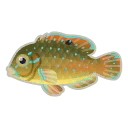
The Blackspot Tuskfish (acronym from now on - BSTF) appeared for a short while in Animal Crossing Pocket Camp for their Fishing Tourney #53, the Oasis Patio. This event occurred during August 2022, and the BSTF hasn't been seen since.
The BSTF is a species of wrasse belonging to Order Labriformes which includes the wrasses, parrotfish, and cales. These fish are most often associated with coral reef habitats and feed on a variety of organisms and algae, depending on species. Within Labriformes is Family Labridae which are the wrasses specifically. They are known to be incredibly colorful, and most are protogynous hermaphrodites, meaning they begin life as females and become male as they grow larger. Some, like the tuskfish (Genus Choerodon), have large, sharp teeth - "tusks" - and powerful jaws they use to crunch on bivalves and other hard prey. The BSTF (Choerodon schoenleinii) is a native to Indo-Pacific near-shore coral reefs, from East Africa out to various Pacific islands, where it does just that.

From https://fishesofaustralia.net.au/home/species/1928
When the BSTF finds a bivalve is just can't crack with its jaws alone, it goes looking for something to help it, like a rock it can smash the bivalve into. In July 2011, this behavior was finally documented, providing evidence to support the notion that wild fish can use tools. At least for BSTF, it was given that seal of approval, as using the rock to help it feed fit the accepted definition of tool use.
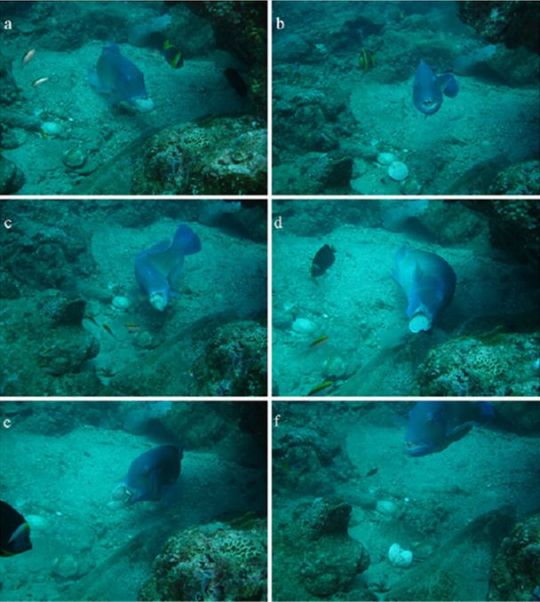
From https://phys.org/news/2011-07-photo-fish-tools.html
Fish are smarter than people give them credit for. At the end of the day, it's really hard to determine how smart a creature like a fish, that has evolved over millennia in an environment so unlike ours, is. We can't simply compare their intelligence to ours, nor should we snub our noses at animals that just don't have it. You wouldn't like it if a fish judged you based on how well you could breathe underwater.
And there you have it! Fascinating stuff, no?
#blackspot tuskfish#fish#animal crossing#animal crossing pocket camp#acpc#animals#marine biology#ocean#science#science in video games#animal crossing fish explained
4 notes
·
View notes
Text
The Ocean AKA Biome Project
The ocean covers up Earth by about 70%
Ah, the ocean.
A place that is just water, fishes swimming around. And if you're lucky, you might see a beautiful and colorful coral reef.
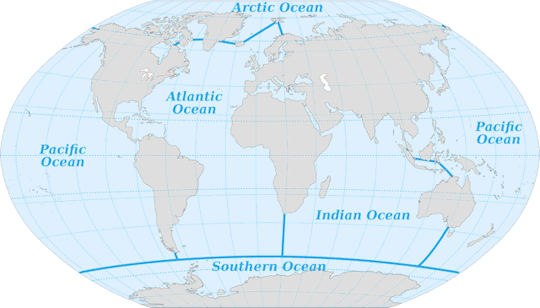
Characteristics of the Ocean:
The temperatures in the ocean are pretty low depending on how deep you go. Anywhere from -40 degrees Fahrenheit to over 100 degrees Fahrenheit. The coldest parts are the ones closest to the North and South poles.
The average precipitation of the ocean is 100 inches per year if it's average. Oceans also carry most of Earth's rain because the ocean is large and the water cycle runs quicker on oceans because oceans are made of water.
The wind in the ocean is pretty harsh because it's mostly happening on the surface, hence why fish tend to go with the currents of the ocean.
Yes, oceans do have seasons. Because it is caused by cycles in evaporation and precipitation that change in the weird thing known as the global weather cycle.
Plants in the ocean:
Seaweed is a plant near the surface parts of the ocean. The entire species adapted by evolving roots tough enough to avoid the ocean´s strong currents, but light enough to produce seeds.

Good seaweed.
Mermaid's wine glass is an type of algae that is one huge cell that is native in the Caribbean and southern Floridan oceans. This species adapted by evolving to grow on small rocks and coral.
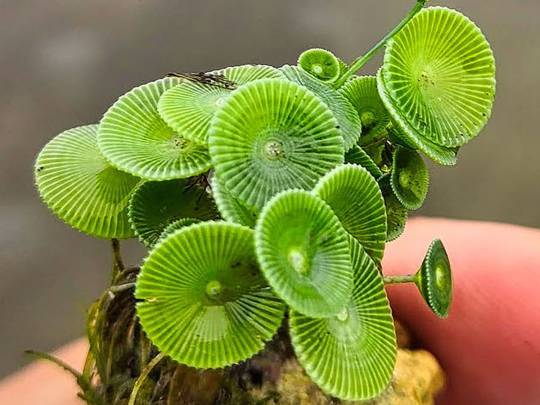
Halimeda is an type of algae that is native in some parts of the Great Barrier Reef. This species of algae has evolved by becoming more tolerant of growing on dead plants and sand.
Carrageenan moss is a type of red algae that grows on the shores of Ireland, Scotland, and Britain. This species of algae evolved to persevere the cold weather of the British Islands by keeping it's roots within the rocky shores.
Animals in the Ocean:
Humpback whales are aquatic mammals that feed in the polar regions of the ocean and migrate to more tropical waters to reproduce. This species adapted to their environment by resting at the surface horizontally to prevent water going into their blowholes because they still need land air, even though they swim way more than they ever walk.
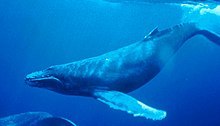
Pacific Oysters are saltwater mollusks that are native in the Pacific coasts of Asia. However, they can also be bred in North America, Australia, Europe, and New Zealand. This species evolved to stick tightly onto rocks with algae via their suctions that they have on their inner bodies.

An average Pacific Oyster
The Blue Tang is an blue and black fish that is native in the reefs of the Philippines, Indonesia, Japan, the Great Barrier Reef of Australia, to name a few. This species evolved a poison and brighter colors to deter predators from consuming it or any of its offspring.
The Red Comb Star is a starfish native to the East Atlantic Ocean near the Mediterranean. This species has evolved little combs that stick onto the ocean floor and catch mollusks at the same time.
Threats to the biome:
Yep, you already know the threats. But I'm going to explain them anyways.
A ton of plastic is thrown in the ocean. One of the reasons why is because of littering. Plastic is a lot more lightweight, but that doesn't stop the wind, rain, or people from throwing them into rivers, drains that lead directly into the ocean, or anywhere that isn't the recycling bin. So imagine a pile of plastic in the ocean with turtles chocking on plastic bags and fish eating the microplastics. This is what you see on the surface.
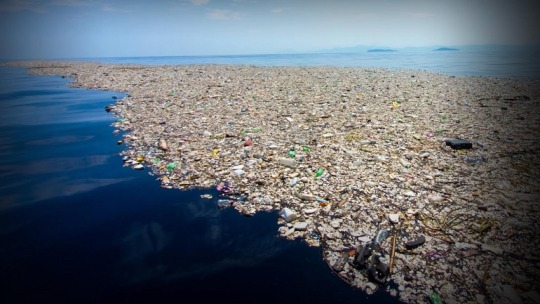
This is only the surface level. The cute turtles and their babies could eat some of this plastic stuff and die!
Oil from man-made oil platforms can spill out into the ocean, or the oil could spill from recreational boats run by people too careless about the environment. This is a threat because the oil could suffocate the many water-breathing ecosystem and the community of different species living there. Don't believe me? Look up the Deepwater Horizon spill of 2010 on Google.
Why You Should Visit:
As long as you are wearing non-faulty scuba gear, then you are gonna have a good time. Because there are a ton of coral reefs with a community of unique fish living in the coral crevices. You can hear the whales sing their majestic songs and the dolphins chirp and play. You can even look at the little seaweed plants float with the current.
Citations:
3 notes
·
View notes
Text
The Essential Pond Filter System to Clear Water
By filtering out leaves, fish waste and uneaten food, a pond filter system will keep your garden pond clean and healthy. These surfaces are ideal for bacteria colonies to grow and transform harmful ammonia in less toxic forms that can be easily absorbed by aquatic animals.

There are many types of pond filter system
Pond Filter Systems come in many different types:
1. Filtration by biological means
Efficient Biofiltering: The biological filtering method is a highly efficient way to eliminate organic wastes and toxic substances. It works by creating an environment that encourages beneficial bacteria. These bacteria help to metabolize harmful substances found in fish wastes, uneaten foods, leaves, and debris within pond ecosystems. They also help to control ammonia levels, which are highly toxic for fish, but promote prolific algae growth.
Clear Water with Natural Filters: The use of natural filters is an effective way to clear murky water. They remove organic debris, toxins and other contaminants. Once installed, they work to continuously clean and clear your pond's water. Filters with mechanical filters are less expensive, but they require frequent cleaning to perform optimally. They also rely on media bed for bacteria growth, which can become clogged with time.
2. Canister Filters
Waste Removal Process: External canister filters combine chemical, mechanical and biological filtration into one unit. These filters are ideal for large tanks of freshwater that require high capacity filtration. Canister filters come in cylindrical containers that contain both the pump as well as the filtration media. Canister filters are operated using the pump of an aquarium. Water is drawn into the filter through a tube, then processed by the filtration media. Solid and liquid wastes, including bacteria, are removed through series of filters.
Controlling Algae and Bacteria Growth: Canister Filters often have an integrated UV sterilizer which works to control the growth of bacteria and algae by exposing them to ultraviolet light. This disrupts the DNA of bacteria and algae, stopping their reproduction. You can add a profiler to control any debris that is already in the filter system before it reaches the main filter. Canister filters work well in larger aquariums such as marine reefs and FOWLR tanks (fish only with living rock), as well as for smaller freshwater aquariums of less than 30 gallons. They can accommodate more media due to their higher pump flow rate. This is a great advantage over power filters and under gravel filters.

3. Power Filters
Clean Water with Pond Filters:Pond filter can keep your backyard water feature clear while supporting the local flora. A healthy pond will also have a positive effect on the environment, as it can sequester carbon and improve air quality.
Optimizing oxygen for aquatic life: Mechanical, biological and ultraviolet filters all play a vital role in maintaining the health your pond ecosystem. Together, they filter out the various nutrients that could otherwise be harmful to wildlife or fish and reduce toxic ammonia levels. They also ensure that the water is properly aerated to prevent stagnant conditions. This will ensure maximum aquatic life.
Breaking Down Ammonia and NitritesBiological Filters are an integral part of any healthy pond eco-system, as they provide a place where beneficial bacteria colonize to help break down levels of ammonia or nitrite that could harm aquatic life. For maximum efficiency, they can be installed either inside or outside of a pond. Their power source is usually an energy-efficient asynchronous magdrive pump.
4. Filter Media
Mechanical vs. The size of your pond and the needs you have will determine which pond filter media you choose. You have a variety of options for filter media, from mechanical filters that collect debris to UV or biological systems that break down harmful substances. You can choose both at the same time.
Beneficial bacteria in biological filters:Biological filter system encourages colonization of beneficial pond bacteria which helps clean pond water at a cellular level. The beneficial bacteria attach to stones and pebbles in natural streams and ponds. They break down the invisible toxins created by fish wastes and decaying organic material into Nitrite. This is then converted into Nitrate, which plants absorb to grow healthy.
Maintaining bacterial health:When buying a biological filter system for your pond, ensure that it is able to handle the fish population you expect and the waste produced by them. To maintain a healthy population of bacteria, cleaning should be done periodically. If you need to clean your pond, use pond water instead of tap water.

Why choose GC TEK?
GC Tek provides innovative and user-friendly filtration system designed to improve the performance of any pond. They have been recognized for their award-winning designs, reliable products and advanced filtration systems that address mechanical and biochemical tasks efficiently. The GC Tek offers exceptional customer service and user-friendly systems that produce clear water clarity in order to maximize aquatic habitat performance.
0 notes
Text
And at this particular moment, coral reefs in the Caribbean need all the urchins they can get. Long-spined sea urchins (Diadema antillarum) play a vital role in Caribbean coral ecosystems. While overpopulated urchins elsewhere are treated as villains—in California, for instance, divers smash purple urchins with hammers to keep them from mowing down kelp forests—Diadema are the Caribbean’s unsung heroes. Dark and rotund with spines radiating in all directions, some as long as knitting needles, the urchins eat massive amounts of algae that would otherwise smother corals or prevent coral larvae from affixing to rocks and growing into colonies. “They’re very simple animals, but they’re very effective at what they do,” says Alex Petrosino, a biologist at The Florida Aquarium and a member of the urchin lab team. Where their radiating spines converge, urchins have delicate, bulbous skeletons with holes for wriggly tube feet and bumps where spines attach. Their mouths—equipped with limestone plates for scraping algae off hard surfaces—are in the middle of that skeleton, on the animal’s underside. Petrosino calls Diadema the janitor of the reef because it’s so efficient at cleaning reef surfaces.
0 notes
Text
Myths About Limestone Stepping Stones That You Must Know

Although Australian landscaping designs are starting to incorporate limestone stepping stones more frequently, there are a lot of false beliefs regarding these stones' suitability for outdoor use. In contrast to their name, limestone stepping stones are incredibly low maintenance and long-lasting, providing homes with attractive and useful options for outdoor flooring. Let us highlight the benefits of placing limestone stepping stones in your backyard and debunk some of the most common myths. A bit more about Limestone first.
An Introduction to Limestone
Sedimentary rocks include limestone. Carbonate of calcium and other organic elements, including fossils, make up the majority of its composition. Over millions of years, calcium carbonate-rich silt deposits started to accumulate and solidify with the remains of marine organisms, most frequently in shallow water environments like reefs and seas. This is how limestone was formed. Coral, algae, and fossilized shells are a few examples of these animals. In the process, the components adhere to one another as the weight of the sediment bears down on the layers below, forcing the emerging stone to consolidate, compact, and cement. This sediment becomes crystallized under pressure and heat, yielding limestone, a solid form. This process can go on and produce an ever denser stone, depending on the repository.
Myth #1: Limestone stepping stones are not durable
Limestone stepping stones are manufactured at exceptionally high temperatures, making them tougher, denser and more durable than other paving materials. They are also more scratch-resistant than concrete, real stone and timber and they are less prone to be harmed by furniture movement and other abrasive surfaces. Limestone stepping stones are more robust and ideal for commercial locations with significant foot traffic. They can also be utilised on driveways when wet. Overall, Limestone stepping stones are among the most durable options for outdoor spaces.
Myth #2: Limestone stepping stones feel hot underfoot
When it comes to the temperature of your outdoor flooring, the colour, not the material composition, has the greatest impact on its heating and cooling capabilities. According to industry testing, the temperature of Limestone stepping stones is comparable to natural stone pavers of the same colour, with darker pavers producing higher surface temperatures than lighter ones. In general, Limestone stepping stones feel cooler to the touch than concrete pavers.
Myth #3: Limestone stepping stones are stain magnet
Do you think the porous structure of Limestone stepping stones makes them more prone to discolouration and difficult to maintain? Think again.
When sealed with a breathable sealant like concrete pavers, Limestone stepping stones can withstand ordinary mistakes such as rust and grease from a grill, wine or ketchup from a party or tyre marks on a driveway. It won't prevent the stain, but you can make cleaning it up much easier since it won't penetrate the stone. Cleaning is simple; an environmentally friendly degreaser and a light pressure washer can remove 99% of all stains on Limestone stepping stones. No harsh chemicals or acids are required, which benefits not only the landscaping workers but also the turf and ornamentals around the house.
Myth #4: Limestone stepping stones are quite difficult to clean
This myth is not real. Limestone stepping stones are extremely durable and require little to no care once installed. We only advise that if you choose Limestone stepping stones, seal it. It is recommended for all pavers to lengthen their lifespan, especially Limestone stepping stones, due to their high porosity. Sealing your stones prevents spills and impurities from infiltrating the surface, making cleaning much easier.
This protects the stone's integrity as well. You should reseal as needed. The average duration between resealing is three to five years. If you wipe up spills as soon as they happen and seal them regularly, you should have no trouble keeping your pavers clean.
Myth #5: Limestone stepping stones are slippery
Limestone stepping stones are slip-resistant and can be used outdoors, even around pools and spas. It is advisable to choose pavers that meet Australian non-slip specifications.
Myth #6: Limestone stepping stones are not sustainable
The last myth we'll dispel is the idea that the extraction of natural stones has a negative environmental impact. As with the cost argument, it is better to put in more work up front because limestone stepping stones last longer than manufactured materials.
What applications are there for Limestone stepping stones?
They are a gorgeous stone option that can transform any space. Limestone stepping stones has a multitude of applications, including but not limited to:
Walkways and Paths
Entertainment areas
Patios
Fire pits
Discover Other Limestone Stepping Stones Myths
If you are still interested in Limestone Stepping Stones but have concerns about what you have heard, simply contact Impression with your queries. Limestone is a stunning, elegant natural material that can transform any home's decor. Once you've decided it's the right material for you, you can work out how to customise it, what colour to use and where to position it. Wherever Limestone stepping stones end up, they will enhance the room's overall elegance and value.
0 notes